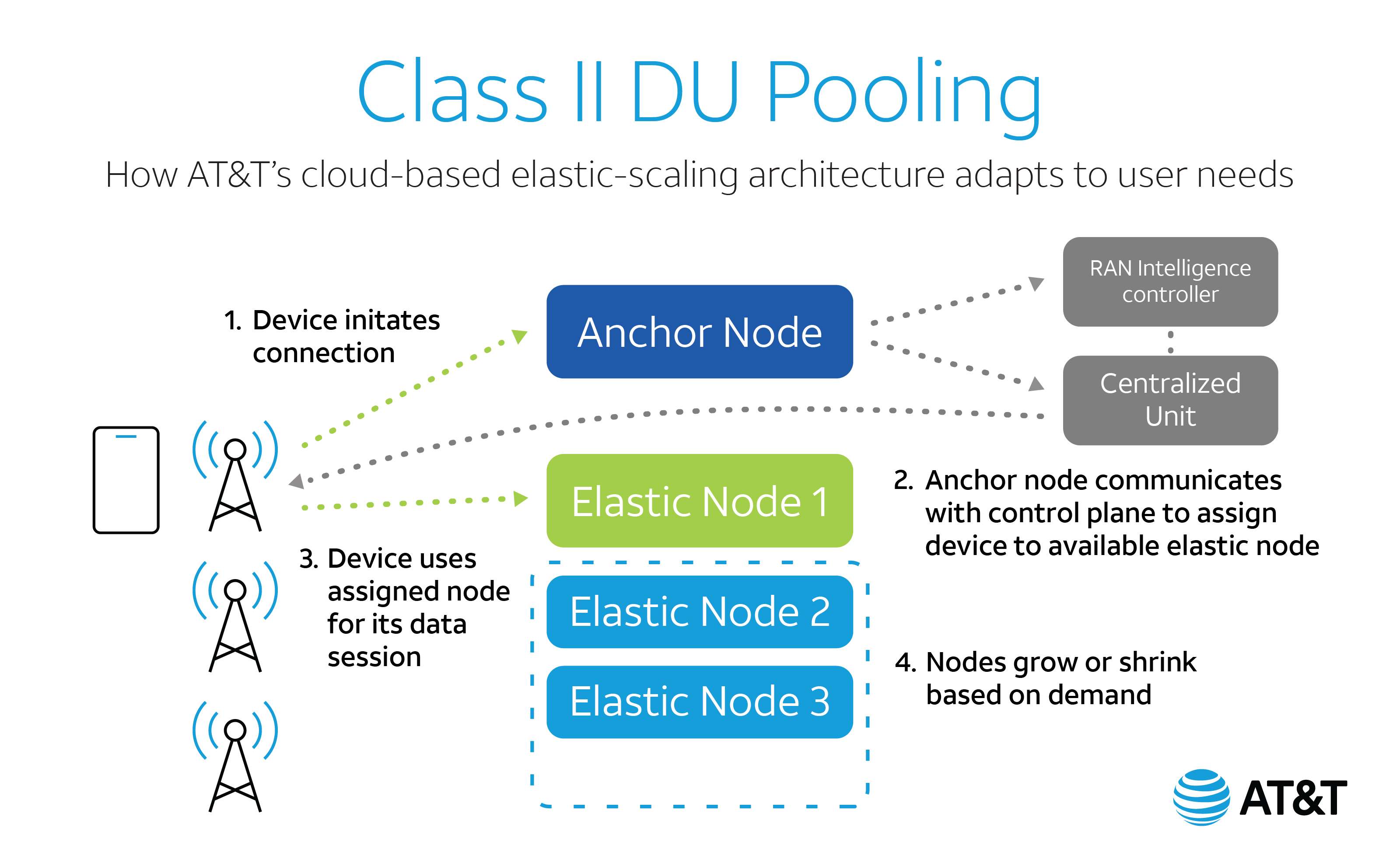AT&T and Intel co-develop industry-leading advanced RAN pooling technology freeing 5G radios from the limitations of dedicated base stations, while enabling more efficient, resilient, and green 5G networks.
In today’s data-driven communications world, it’s hardly possible to go even a few hours without mentioning the word “cloud.”
So, what is the cloud’s (not so) secret superpower that has allowed it to grow to such a prominent place in our lives in a few short years? One leading answer is elastic scaling – the ability to use only as much computing hardware as you need at any time, flexibly growing or shrinking the servers needed for complex tasks as demand changes.
Towards Elastic Networks
Elastic scaling allows the Internet services we know and love to remain efficient and eco-friendly. By vacating unneeded servers constantly, servers that usually consume a lot of power can now be recycled for other tasks and put to sleep to save energy – all while substantially reducing the number of servers and equipment needed.
What’s more, elastic “active-active” scale-out architectures also provide a more reliable service. Because we are essentially requiring software to be written in a way that it isn’t strongly tied to a particular piece of hardware, when one piece of equipment fails, another can instantly take over its tasks.
Because of all its benefits to our planet, our customers and our shareholders, operators like AT&T have been racing to elasticize their 5G networks. At AT&T we’ve been transitioning our mobility core network to a virtualized version since 2014. As of 2020, we’ve virtualized more than 75% of our network functions. That is, everywhere except the Radio Access Network, or the RAN.
The Radio Access Network
Achieving elasticity in the RAN brings a completely different set of challenges to resolve. The RAN base station distributed units (DUs) are one of the most distributed, resource intensive, and complicated parts of a wireless network. It’s where that video conference with your coworkers or those vacation photos that you’re downloading are transformed from data packets into the radio waveforms that are transmitted and received by the radios at the top of cell towers.
DUs have to coordinate with radios in microseconds. In comparison, most Internet services operate at timescales of milliseconds or over a thousand times slower. DUs have to extract meaningful signals from noisy waveforms with all kinds of signal interference, and they are responsible for making sure that radio spectrum, a valuable and limited natural resource worth billions, is shared fairly and efficiently across all the other users in the neighborhood.
Due to these hyper-stringent requirements, radios have traditionally needed to be physically connected to baseband equipment dedicated to the radio and ready to go at a microsecond’s notice even if it’s the middle of the night and nobody is using the radio. And so, the mapping between radios and servers was not very elastic. At least until now.
Distributed Unit Pooling

At AT&T, we’ve been working hard to tackle the challenge of elasticity in the RAN. And through a close collaboration with Intel, we have developed new cutting edge technology – we call it Advanced DU pooling and it’s designed to deliver unprecedented levels of elasticity in the RAN. Itwill eventually be usable by the entire 5G operator community to drive the telecom industry’s goals of green and efficient wireless networks forward.
DU pooling provides the greatest value in C-RAN or Centralized RAN network deployments where RAN baseband equipment from many cell sites are “pooled together” into a “cloud” of general purpose processors in far edge data centers or central offices. Furthermore, through an advanced form of DU pooling called Class II pooling, a single 5G radio can now distribute the baseband processing for each user device in the cell across multiple servers.
This means that your video conference stream’s packets can be processed by a different baseband server than your rideshare driver’s navigation application data even though you are both connected to the same radio and sharing the same airwaves. It gives unprecedented elasticity and flexibility to the network to distribute (and redistribute) traffic instantly. If a baseband server becomes overloaded or fails, all impacted user sessions can be moved to a different server without any disruption to customers. And when traffic levels fall, the RAN can consolidate user sessions into fewer servers, putting the unused servers to sleep for even greater efficiency in operating the RAN.
Looking back to look ahead
DU pooling technology was made possible by combining AT&T’s deep knowledge of Open RAN technologies as one of the co-founders of the O-RAN Alliance with Intel’s expertise in general purpose processors and software-based RAN through its FlexRAN™ software stack running on Intel 3rd generation Intel® Xeon® Scalable processors. The open standards for communications between radios and DUs that were published by O-RAN enabled its development, and the result is a technology demonstrator implemented on FlexRAN software.
As we look ahead, AT&T is working with our RAN suppliers to incorporate DU pooling technology into commercial RAN software products that can be deployed on the nation’s most reliable 5G network, AT&T 5G.1 We are optimistic that the technology will allow AT&T to provide our customers with an even more reliable and higher perfoming network while helping us to meet our commitment of a carbon neutral network by 2035. Eventually, this technology could be made available to all operators so the entire industry can benefit.
PR Archives: Latest, By Company, By Date